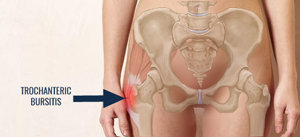Hip Bursitis (Trochanteric Bursitis)
What is the hip bursa (trochanteric bursa)?
The hip bursa (trochanteric bursa) is a protective sac of fluid at the outside of the hip joint at the widest part of hips where the thigh bone protrudes close to the skin.
What is hip bursitis (trochanteric bursitis)?

Hip bursitis occurs when the bursa becomes inflamed or irritated
What causes hip bursitis?
There are many potential causes of hip bursitis. Most commonly it can be due to a complex combination of weakness, instability and tendon damage of the gluteal tendons. Occasionally this can occur due to limitations of the hip joint (such as arthritis). Bursitis can also occur due to direct impact, bone spurs, gout and rheumatoid arthritis.
What are the symptoms of hip bursitis?
The most common feature is pain and tenderness when lying directly on the effected side. Often there is also pain walking up or down stairs. Sometimes there is also pain initiating new movement after prolonged sitting and lying.
How is hip bursitis diagnosed?
Usually hip bursitis is diagnosed by an expert clinician without the need for investigations. Sometimes further tests can be needed to identify the underlying cause particularly if the condition doesn’t resolve with initial treatment.
What is the treatment for hip bursitis?
Treatment depends entirely on the cause. A cortisone injection can be very effective if excessive inflammation is involved. The underlying cause must also be addressed and this could involve treating the hip joint or improving you gluteal tendon strength and pelvic stability – often with the help of a physiotherapist.





















